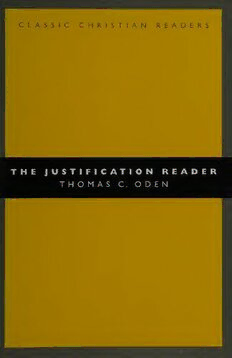
The Justification Reader PDF
Preview The Justification Reader
THE JUSTIFICATION READER THOMAS C. ODEN THE JUSTIFICATION READER CLASSIC CHRISTIAN READERS The Justification Reader FORTHCOMING VOLUMES The Good Works Reader THE JUSTIFICATION READER Thomas C. Oden William B. Eerdmans Publishing Company Grand Rapids, Michigan / Cambridge, U.K. © 2002 Wm. B. Eerdmans Publishing Co. All rights reserved Wm. B. Eerdmans Publishing Co. 255 Jefferson Ave. S.E., Grand Rapids, Michigan 49503 / P.O. Box 163, Cambridge CB3 9PU U.K. www.eerdmans.com Printed in the United States of America 07 06 05 04 03 02 7654321 ISBN 0-8028-3966-5 Unless otherwise noted, patristic quotations derive from the Ancient Christian Commentary on Scripture, reprinted by permission of InterVarsity Press. Contents Abbreviations xiv Introduction 1 1. The Promise 1 2. The Heart of the Gospel 2 A. The Special Comfort of God’s Free Grace 3 1. The Unique Blessing of Justification 3 2. Basic Definitions 3 B. The Centrality of Justification in Christian Teaching 4 1. The Decisive Baseline of Evangelical Teaching 4 2. Why Is It a Comforting Doctrine? 5 3. The Limits of Our Powers of Restitution 6 C. Why a Justification Reader? 6 1. It Provides a Model for Classic Christian Reasoning 7 2. Why Is Justification Teaching Especially Pertinent Today? 7 3. Simplicity 8 4. On the Genre of the “Reader” 8 5. Why Have These Texts Remained Shockingly Inaccessible Elsewhere? 10 6. A Welcoming Note for Orthodox and Catholic Readers 11 v CONTENTS PART ONE JUSTIFICATION CHAPTER ONE The Ancient Fathers on Evangelical Justification 15 A. Typical Misconceptions of Classic Christian Teaching on Saving Faith 15 1. Peacemaking among the Divided Faithful 15 2. My Simple Thesis 16 3. Why the Classic Christian Consensus Is Not Properly Described as Either European or Western 17 4. Why This Presentation of Evidence Is So Urgently Needed amid Uncharitable Polemics among Evangelicals, Liberals, Catholics, and Orthodox Today 18 5. How Both Evangelical and Liberal Assumptions Have Tilted the Perception of Ancient Orthodox Christian Salvation Teaching 19 6. Liberal Misconceptions 21 B. The Unexplored Connection: The Fathers Were Not Ignorant of the Pauline Teaching of Justification 23 1. What Is Meant by “Patristic”? 23 2. The Unity of the First Five Centuries Contrasted with the Conflict of the Last Five Centuries 24 3. Remembering the Fathers’ Continuous Immersion in the Written Word 26 4. The Practical Impact 26 5. Why Dangerous? The Alarming Consequence of the Rediscovery of the Unity of the Body of Christ 28 6. Why Does This Recognition Have a Painful Edge for Protestants? 28 7. Can Christian Teaching Be Trusted If It Lacks Scriptural Grounding and an Orthodox Historical Textuary? 29 8. Ecumenical Dialogue Needs These Arguments 29 vi CONTENTS 9- Assessing the Joint Declaration 31 10. The Growing Hunger for Greater Evangelical Unity in the Gospel 32 11. The Search for Balance and the Hazard of Presenting Too Little Evidence or Too Much 33 12. Fairly Assessing the Evidence 35 CHAPTER TWO Justification Defined 36 A. Rehearsing the Classic Consensus on Justification 36 1. What Is Justification? 36 2. The Way to Consensus 38 3. Representative Reformed Confessions on Justification 39 4. The Lutheran Formula of Concord 40 5. Baptist Confessions 40 6. Anglican Tradition 41 7. Wesleyan Traditions 41 8. Pentecostal Traditions 42 9. Arguing Consensuality 43 B. Introducing Locus Classicus Patristic Texts on Justification 44 1. Early Eastern Voices on Justification 44 2. Early Western Voices on Justification 45 3. A Case in Point: Consensual Interpretation of Ephesians 2 47 4. Whether These Voices Harmonize: Modest Objectives on Doctrinal Concurrence 49 C. God’s Costly Way of Reestablishing a Right Relation with the Sinner 50 1. Comparing Old and New Testament Interpretations of Justification 50 2. Old Testament Anticipations 50 3. Why Do We So Fiercely Resist Hearing This Good News? 51 vii CONTENTS 4. While You Were Yet Ungodly 52 D. How Divine Love Brings Sinners into an Uprighted Relation with Divine Justice 53 1. Unpacking the Courtroom Metaphor 53 2. The Judge and the Law 54 3. Elements of the Courtroom Drama 54 4. Our Advocate 55 5. How Clemency Comes Late in the Trial 55 6. The Acquittal 56 7. There Is Now No Condemnation 57 8. Behavioral Righteousness Distinguished from Juridical Righteousness 58 CHAPTER THREE Receiving Righteousness from God 60 A. Justified by His Blood 60 1. In What Sense Is Christ “Made to Be Sin for Us”? 60 2. Expiation 62 3. Justified by His Blood 63 4. Much More Are We Saved by His Blood 64 5. What Is Redemption? 65 6. The Exchange 65 B. How Righteousness Is Revealed 66 1. Righteousness Belongs to God 66 2. Righteousness Revealed in Creation and Conscience 67 3. Righteousness Revealed in the Gospel 68 4. Giving Account on the Last Day 68 C. Our Appropriation of Gods Righteousness 69 1. Christ Is Our Only Righteousness 69 2. Sin Made Apparent by the Law 70 viii
